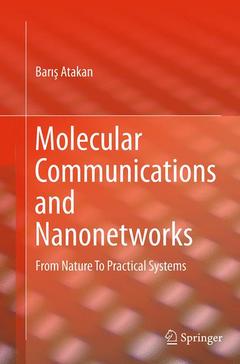Description
Molecular Communications and Nanonetworks, Softcover reprint of the original 1st ed. 2014
From Nature To Practical Systems
Author: Atakan Barış
Language: English
Subjects for Molecular Communications and Nanonetworks:
Keywords
Active Molecular Communication; Active Transport; Brownian Motion; Calcium (Ca2+) Signaling; Carrier Molecules; Diffusion; Fick's Law; Gap Junction; Gradient Sensing; Inter-cellular signaling; Ligand-Receptor Binding; Molecular Communication; Molecular Motors; Motility of Bacteria; Nanomachine; Nanomedicine; Nanonetworks; Nanorobot; Nanotechnology; Passive Molecular Communication; Passive Transport; Quorum Sensing; Synthetic Biology
Approximative price 105.49 €
In Print (Delivery period: 15 days).
Add to cartPublication date: 10-2016
Support: Print on demand
Approximative price 105.49 €
In Print (Delivery period: 15 days).
Add to cartPublication date: 04-2014
184 p. · 15.5x23.5 cm · Hardback
Description
/li>Contents
/li>Biography
/li>Comment
/li>
Communications at Nanoscale.- Why do we need communication at nanoscale?.- Frontier applications of nanoscale communications.- Nanoscale Communications in Nature.- Why does the Nature need nanoscale communication?.- Nanoscale communications in Nature.- Adaptation and Inspiration from the Nature: Towards Molecular Communication Systems and Applications.- Active Molecular Communication.- Passive Molecular Communication.- Gap Junction Molecular Communication.- The Existing Molecular Communication Systems and Applications.- Molecular Transmitters.- Molecular Receivers.- Molecular Encoding Mechanisms.- Molecular Decoding Mechanisms.- Molecular Communication Applications.- The Envisioned Molecular Communication Systems and Applications.- Feasibility of the Envisioned Molecular Communication Systems.- Information Theoretical Foundations of Molecular Communication.- Molecular Channel.- Molecular Channel Characteristics.- Noise in the Molecular Communication Channel.- Attenuation in the Molecular Communication Channel.- Capacity of the Molecular Communication Channel.- Optimal Encoding and Decoding for Molecular Communication.- Molecular Modulation.- Molecular Nanonetworks.- Networking in Molecular Nanonetworks.- Molecular Medium Access Control.- Molecular Routing.- Molecular Transport.- Molecular Addressing.- Application Example: Body Area Nanonetworks with Molecular Communication.- Application Example: Nanosensor Networks with Molecular Communication.
Introduces the concept of molecular communications and nanonetworks by reviewing the diverse sets of literature from the different research domains such as biophysics, biochemistry, synthetic biology and communication.
Highlights the communication theoretical viewpoints and different modeling approaches which are used to understand the nature-made molecular communication phenomena
Examines the roles of molecular communications in many promising applications such as cancer cell detection and elimination with the communicating engineered bacteria and the signal processing applications with a colony of communicating bacteria
Includes supplementary material: sn.pub/extras




